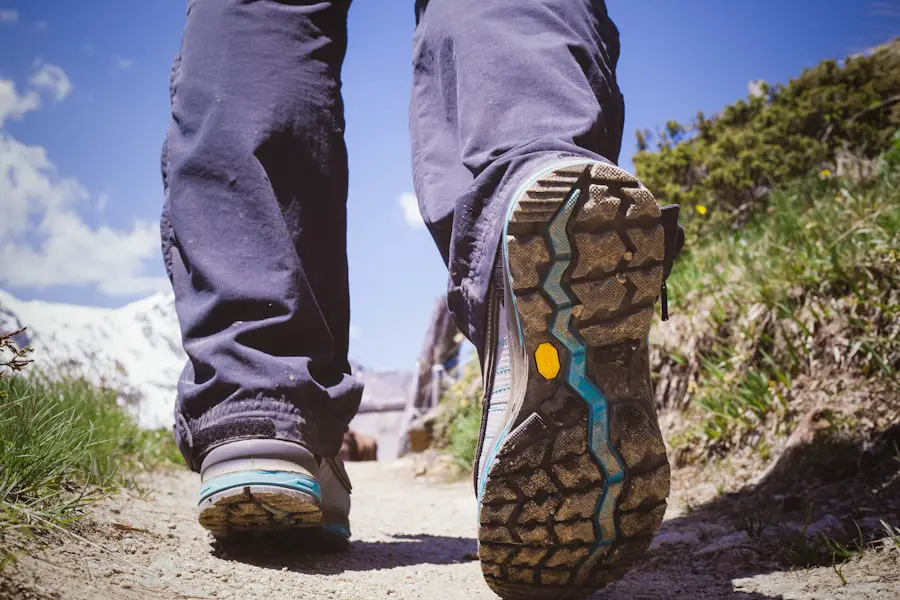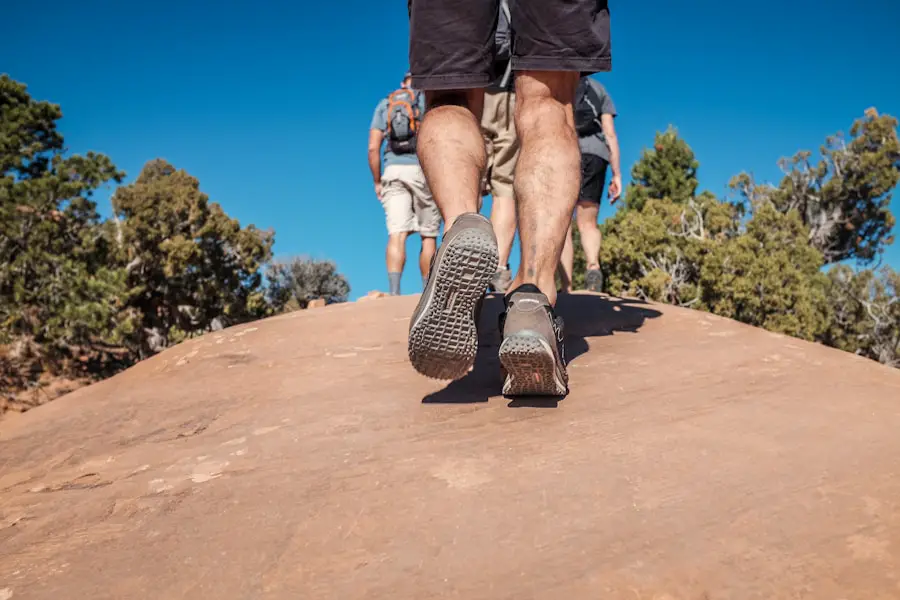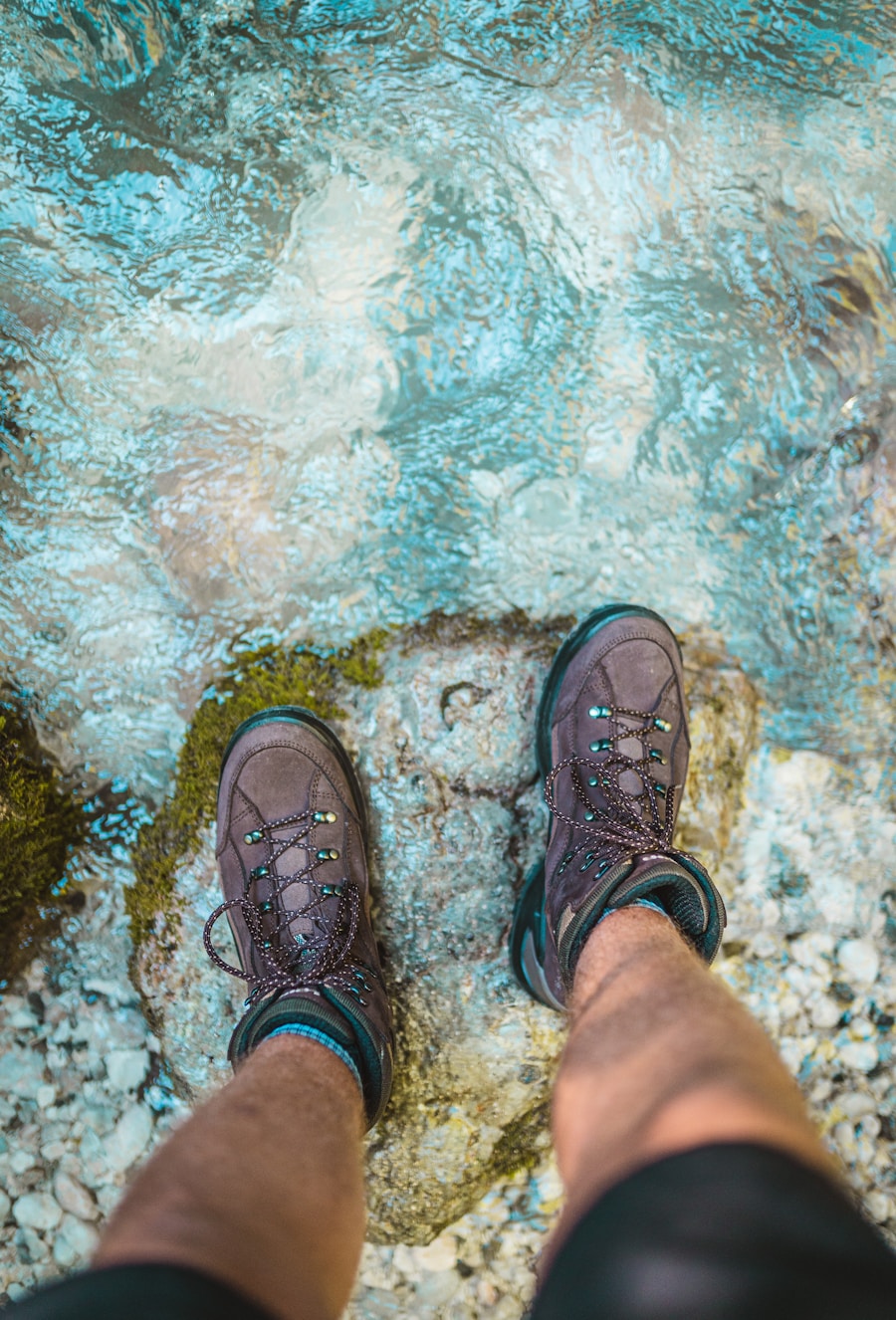Footwear plays a crucial role in our daily lives, influencing not only our comfort but also our overall health. The right shoes can enhance performance, prevent injuries, and provide the necessary support for various activities. When it comes to walking, especially over long distances or on uneven terrain, the importance of proper footwear becomes even more pronounced.
Shoes that are designed specifically for certain activities can help mitigate the risk of foot-related ailments such as plantar fasciitis, bunions, and other musculoskeletal issues. Moreover, the right footwear can significantly affect posture and alignment. Shoes that lack adequate support can lead to misalignment of the feet, which in turn can cause problems in the knees, hips, and lower back.
This is particularly relevant for individuals who spend a considerable amount of time on their feet, whether for work or leisure. Investing in quality footwear tailored to one’s specific needs is not merely a matter of comfort; it is an essential aspect of maintaining long-term health and well-being.
Key Takeaways
- Proper footwear is important for maintaining foot health and preventing injuries, especially when walking on concrete surfaces.
- Hiking shoes are designed with specific features to provide better support, stability, and protection compared to regular shoes.
- Walking on concrete can have a significant impact on the feet, leading to discomfort, fatigue, and potential long-term issues if not addressed.
- Using hiking shoes for concrete walking can provide benefits such as better cushioning, support, and traction, reducing the impact on the feet.
- However, there are drawbacks to using hiking shoes for concrete walking, such as increased weight and stiffness, which may not be suitable for everyone.
- When choosing footwear for concrete walking, consider factors such as cushioning, support, flexibility, and breathability to find the best option for your needs.
- Alternatives to hiking shoes for concrete walking include athletic shoes with adequate support and cushioning, as well as specialized walking shoes.
- Ultimately, finding the best footwear for concrete walking depends on individual preferences, foot conditions, and the specific demands of the activity.
Differences Between Hiking Shoes and Regular Shoes
Hiking shoes are specifically engineered to meet the demands of outdoor activities, offering features that set them apart from regular shoes. One of the most significant differences lies in the construction and materials used. Hiking shoes typically incorporate durable materials that can withstand rough terrains, such as leather or synthetic fabrics that resist abrasions and water.
In contrast, regular shoes often prioritize style over functionality, using lighter materials that may not provide the same level of protection or durability. Another key distinction is the sole design. Hiking shoes usually feature a rugged outsole with deep lugs for enhanced traction on slippery or uneven surfaces.
This is essential for maintaining stability while navigating rocky trails or muddy paths. Regular shoes, on the other hand, often have flatter soles that are designed for smooth surfaces, which may not offer adequate grip when faced with challenging conditions. Additionally, hiking shoes often come with reinforced toe caps and ankle support to protect against impacts and provide stability, features that are generally absent in standard footwear.
Impact of Concrete Walking on Feet

Walking on concrete surfaces can have a profound impact on foot health due to the hardness and unforgiving nature of such surfaces. Concrete does not provide any cushioning or shock absorption, which means that every step taken can lead to increased stress on the feet and joints. Over time, this can result in various issues such as heel pain, arch discomfort, and even chronic conditions like plantar fasciitis.
The repetitive impact associated with concrete walking can exacerbate these problems, leading to inflammation and pain. Furthermore, the lack of flexibility in concrete surfaces can contribute to muscle fatigue. When walking on softer surfaces like grass or dirt, the feet can adapt more easily to changes in terrain, allowing for a more natural gait.
However, concrete forces the feet into a rigid pattern of movement that can lead to overuse injuries. Individuals who frequently walk on concrete—such as those in urban environments or certain professions—may find themselves experiencing discomfort more acutely than those who walk on more forgiving surfaces.
Benefits of Using Hiking Shoes for Concrete Walking
| Benefits of Using Hiking Shoes for Concrete Walking |
|---|
| 1. Shock Absorption |
| 2. Arch Support |
| 3. Stability and Traction |
| 4. Durability |
| 5. Comfort |
| 6. Protection from Debris |
Using hiking shoes for walking on concrete can offer several advantages that enhance comfort and reduce the risk of injury. One of the primary benefits is the superior cushioning that many hiking shoes provide. Designed to absorb shock and reduce impact, these shoes can help mitigate the stress placed on the feet when walking on hard surfaces.
This cushioning is particularly beneficial for individuals who may already be prone to foot pain or discomfort. Additionally, hiking shoes often feature excellent arch support, which is crucial for maintaining proper foot alignment during prolonged periods of walking. This support helps distribute weight evenly across the foot, reducing pressure points that can lead to pain or injury.
The rugged outsoles of hiking shoes also provide better traction than regular shoes, which can be advantageous when navigating slick or uneven concrete surfaces. This combination of cushioning, support, and traction makes hiking shoes a viable option for those who find themselves frequently walking on concrete.
Drawbacks of Using Hiking Shoes for Concrete Walking
Despite their benefits, there are also drawbacks to using hiking shoes for concrete walking that should be considered. One significant concern is weight; hiking shoes tend to be heavier than regular walking shoes due to their robust construction and additional features designed for outdoor use. This added weight can lead to fatigue over long distances, particularly if one is not accustomed to wearing heavier footwear.
Another potential drawback is breathability. Many hiking shoes are designed with waterproof materials to protect against wet conditions, which can limit airflow and lead to overheating during extended periods of wear on hot concrete surfaces. This lack of ventilation may result in discomfort or excessive sweating, which could contribute to blisters or other foot issues.
Additionally, while hiking shoes offer excellent support and traction for uneven terrain, they may not provide the same level of flexibility as specialized walking shoes designed specifically for urban environments.
Tips for Choosing the Right Footwear for Concrete Walking

When selecting footwear for walking on concrete, several factors should be taken into account to ensure optimal comfort and support. First and foremost, it is essential to consider the fit of the shoe. A well-fitting shoe should provide enough room in the toe box while securely holding the heel in place to prevent slippage.
Trying on shoes at the end of the day when feet are slightly swollen can help ensure a proper fit. Cushioning is another critical aspect to evaluate. Look for shoes with ample padding in both the midsole and insole to absorb shock effectively.
Additionally, consider arch support; individuals with flat feet may require more structured support compared to those with high arches. It’s also advisable to pay attention to the outsole material; rubber outsoles with good tread patterns will enhance grip and stability on concrete surfaces.
Alternatives to Hiking Shoes for Concrete Walking
While hiking shoes can be beneficial for concrete walking, there are several alternatives that may also provide comfort and support without some of the drawbacks associated with heavier footwear. One popular option is athletic walking shoes specifically designed for urban environments. These shoes often feature lightweight materials and enhanced breathability while still providing adequate cushioning and arch support.
Another alternative is trail running shoes, which combine elements of both running and hiking footwear. They typically offer a lightweight design with good traction and cushioning, making them suitable for both concrete walking and light trail use. Additionally, some brands offer specialized urban walking shoes that focus on comfort and style without sacrificing functionality.
These options often incorporate advanced materials that enhance breathability while providing necessary support for long periods spent on hard surfaces.
Finding the Best Footwear for Your Needs
Selecting the right footwear is essential for anyone who spends significant time walking on concrete or engaging in outdoor activities like hiking. Understanding the differences between various types of shoes—such as hiking shoes versus regular footwear—can help individuals make informed choices based on their specific needs and activities. While hiking shoes offer numerous benefits such as cushioning and support, they may not always be the best option for every situation due to their weight and breathability issues.
Ultimately, finding the best footwear involves considering personal comfort preferences, foot shape, and intended use. Whether opting for hiking shoes or exploring alternatives like athletic walking or trail running shoes, prioritizing proper fit and support will contribute significantly to overall foot health and comfort during any activity.
If you are wondering if hiking shoes are good for walking on concrete, you may also be interested in learning about the benefits of traveling on short-term disability. Traveling on short-term disability can provide individuals with the opportunity to explore new places and take a break from their daily routine. To find out more about this topic, check out this article.
FAQs
What are hiking shoes?
Hiking shoes are footwear designed for outdoor activities such as hiking, trekking, and walking on uneven terrain. They are typically designed to provide stability, support, and protection for the feet during outdoor activities.
Are hiking shoes good for walking on concrete?
Hiking shoes are not specifically designed for walking on concrete, but they can provide adequate support and cushioning for short periods of time. However, they may not be as comfortable as shoes specifically designed for urban walking on hard surfaces.
What are the benefits of wearing hiking shoes on concrete?
Hiking shoes can provide better support and stability compared to regular sneakers when walking on concrete. They may also offer more protection and durability, making them suitable for urban walking if no other options are available.
Are there any drawbacks to wearing hiking shoes on concrete?
Hiking shoes may not provide the same level of cushioning and shock absorption as shoes designed for urban walking on concrete. They may also be heavier and less breathable, which can lead to discomfort during extended periods of walking on hard surfaces.
What should I consider when choosing hiking shoes for walking on concrete?
When choosing hiking shoes for walking on concrete, consider factors such as cushioning, support, breathability, and weight. Look for shoes with adequate cushioning and support to minimize the impact on your feet and joints. Additionally, consider the weight and breathability of the shoes to ensure comfort during urban walking.
